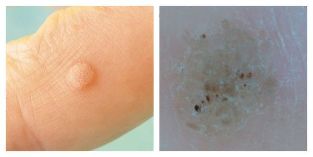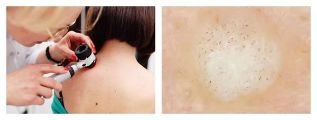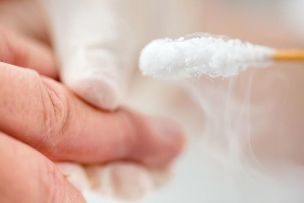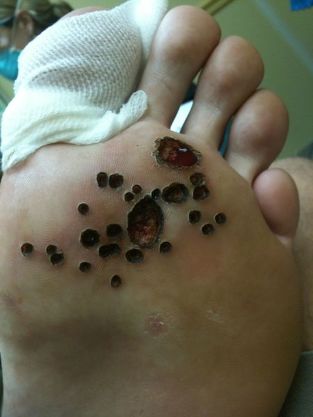What is warts? We will analyze the cause, diagnosis and treatment in an article by a dermatologist with 37 years of experience.

Definition of disease. The cause of the disease
Wartsare benign skin lesions with irregular light in the form of local overgrowth of the upper skin layer (epidermis) with papules (nodules) orarray.
The incidence of warts in adults is 7-12%, in school-age children - up to 10-20%.
Warts are very similar to other types of warts on the skin. Usually, a person cannot accurately identify the disease on their own, so a dermatologist must be consulted to make a diagnosis.
The human papillomavirus is the cause of the warts. The type of virus affects what type of warts can develop. As a result, each human papilloma virus infects the tissue at its most characteristic location.
| Type HPV | Localization with |
priorityTypes of warts |
|---|---|---|
| 1 | Feet, knees, palms, hands, fingers |
Palm and palm warts, simple warts rarely |
| 2, 4 | Hands, fingers, knees, less often - feet |
Simple warts, occasional warts, palms and |
mosaic warts
| 3, 10 | Shins, hand, face | Flat warts |
| 7 | Hands, fingers | Butcher's Warts |
| 5, 8, 9, 12, 14, 15, 17, 19-24 |
Face, arm, front body |
Thriving epidermal form |
Virus transmission usually occurs through contact - direct contact between infected and healed skin (eg by shaking hands) or indirectly (through handrails, toys, etc. ). As a result, you can get infected with the human papillomavirus, which causes warts in many different places - on public transport, school, work, at home, highly exposed places and the environment. wet (swimming pools, saunas, gyms). Minor trauma to the epidermis, through which the virus invades, as well as dermatitis, contributes to infection.
Also contributes to the appearance of warts:
- immunodeficiency (including HIV infection);
- warm and humid environments;
- needs professional contact with meat and fish ("meat warts").
Certain human papillomaviruses are passed from parents.
But toads and frogs, despite the horror stories we often fear in our childhood, cannot be infected - this is one of the most common myths about the disease, having no muscles. department.
If you experience similar symptoms, consult your doctor. Do not self-medicate - it is dangerous to your health!
The wart symptoms
Symptoms will vary depending on the type of wart.

Common warts:
- Round dense papules of normal color, 1-10 mm or more.
- The surface of the paper sheet has many cracks and layers.
- If the paper is on your finger, the print will disappear and be distorted. The same goes for brushing.
- Warts are simple, single or in pieces - they usually appear where the most injured (hands, fingers, knees) are found.
- When looking with a microscope, the doctor may see small brown spots - thrombosed (clogged) capillaries. Patients often refer to these points as "roots". Here's the main sign for the doctor: it can be used by a dermatologist to distinguish warts from other similar diseases (for example, molluscum contagiosum and keratosis).
Plantar warts (horns):
- The main symptom that often causes patients to see a doctor is pain when pushing and walking.
- Such warts are usually found on the feet.
- As a rule, when contacting a doctor, an uneven, keratinous plaque with the usual color will be visible, although at an early stage you may see a smooth, even papule. . With keratinization, capillaries are only visible when the keratinized layer of the skin is removed.
- The leather style of the sole is distorted.
- Warts are usually solitary, but there are also 2-6 warts;
- these warts are often confused with corn kernels (especially dry) - this is a description of the problem that patients often see.

Flat (juvenile) warts:
- It looks like a round, clear, smooth, normal color, pink or slightly brownish nodule, size 1-5 mm.
- Appears on arms, legs, very often on face.
- There are always a few - they are grouped.
Epidermia verruciform (old age warts):
- Large, round, multiple confluent tumors are normal pink or brown in color.
- Most commonly appears on the face, arms, front of the body.
- May be confused with keratoma, shingles, and skin cancer.
The pathogenesis of the wart
When entering the body, the human papillomavirus can be in a latent state for a long time - the common person is not even aware of its existence. When factors that favor the virus appear, it begins to "multiply" in the epithelium, leading to tissue changes.
Unlike other viruses, human papillomaviruses do not destroy the cells of the epithelium on their own - they die spontaneously, during keratinization and desquamation.
Local and state factors of the immune system influence the spread of the infection. For example, people with HIV or a kidney transplant are more likely to get warts. Furthermore, these tumors are often difficult to treat. With normal immunity, the virus does not affect the deep layers of the skin, so many people develop warts on their own after a few months.
The main stage of the appearance of warts is an increase in the rate of cell division and growth with the help of a virus. The rapid metabolism leads to thickening of the skin layers. As tissues grow in a certain small area, a nodule appears, called a warts.
Classification and stage of development of warts
There is no widely accepted classification for warts. However, there are some common varieties:
- Common wartsare the most common (70% of warts are just them). Such tumors are not felt and are only aesthetically pleasing to one person.
- Plantar warts- appear on the soles of the feet, causing pain, so treatment is needed. Skin injury caused by wearing uncomfortable, tight, loose shoes contributes to such warts.
- Flat warts- more common in adolescents and teenagers. It is due to the unstable endocrine background of the young, affecting the entire body. Usually flat warts are barely visible.
- Juvenile warts- typical for the elderly. They usually appear on the body covered with clothing, but can appear on the face and hands. Without discomfort, such warts should not be treated - the healing process in the elderly can be much slower than in young people due to the slow metabolism.

Other authors distinguish the following types of warts:
- Mosaic warts(HPV 2, 4) - u on the palms of the hands and soles of the feet. They look like keratoses, i. e. , the horny layer thickens (usually on the forefeet), covered with deep cracks.
- Genital warts(HPV 60) is a type that very rarely grows on the feet. It is a soft knot with cracks. When opened, a yellow-white waste appears similar to curd.
- Fluffy wartsare thin clusters of horns that grow near the mouth, nose, or eyes.
- "Butcher's" warts(HPV 7) - appear on the hands and fingers of people who have frequent contact with meat and fish. Presented as a hypertrophic tumor similar to a cauliflower, but of a normal color.
In addition, the types of warts are differentiated depending on their location.
For example, genital warts - tumors that look like tumors that appear on the genitals (especially where the skin has turned to the mucosa) is a common disease. They are usually caused by HPV types 6 and 11.
Complications of warts
The main cause that patients with genital warts go to the doctor are cosmetic defects, affecting the quality of life, the confidence of the patient and developing a lot of complications. Complications can also include surface cracking of the wart and infection, and in some types of warts, pain with movement.
Skin warts usually do not degenerate into a malignant tumor, they are quite harmless, however, in very rare cases such complications can occur in immunocompromised people.
Other complications arise when you try to remove development yourself. In this regard, inflammation and cosmetic defects in the form of scarring can occur, as well as the spread of the virus through the skin, so in the morning after self-eliminating a pimple, a personmay wake up with some new pimples.
Remember that under the guise of warts, a completely different disease can be hidden, you cannot identify this disease without the advice of an experienced doctor.

Diagnosis of wart
Exam (clinical image) and history (medical history) are usually sufficient for diagnosis.
To confirm the diagnosis, the doctor may conduct a histological examination - studying the cells of the tumor.
It is very important to perform a differential diagnosis - to distinguish warts from other diseases. For example,common wartsmust be distinguished from the following diseases:
- Molluscum contagiosum- usually occurs on the body and genitals, less commonly on the hands and feet. It is a hemisphere with an impression on the surface; when pressed from the sides, a white "cry" is released.
- Epidermal fold- a person is often more solitary, since birth. It protrudes above the surface of the skin, usually covered with hair.
- Basalioma- a tumor in the form of a nodule, covered with a crust in the center. Typical for the elderly.
Plantar wartsmust be distinguished from the following:
- Keratoderma- large areas of keratinized and inflamed skin. No blood capillaries.
- Palmar-plantar syphilid- painless lumps, peeling skin along the periphery. The reaction to syphilis is positive.
- Corners- usually painless, can only be painful when pressed vertically.
Your doctor must also distinguish other types of warts from certain diseases. If another pathology is suspected, the doctor may order an additional diagnosis (for example, detection of antibodies to a virus, CT, or MRI).
Treatment of warts
Warts are treated for cosmetic purposes and improve the patient's quality of life. It can be prescribed only by a doctor after an accurate examination and diagnosis. Independent attempts to remove warts are unacceptable, as a patient without the medical education and necessary equipment cannot accurately identify the disease and its complications after "treatment". as such occurs much more frequently than recovery.
There are several ways to treat warts. All of them are usually done under the supervision of a doctor and some - only in the treatment room of the clinic.

Chemical treatment
A combination of milk salicylic and salicylic patch is used to remove warts. The percentage of drugs and the method of using them (wearing the patch, applying them over a long period of time, etc. ) depends on the prevalence and location of the cancer.
A solution of zinc and 2-chloropropionic acid can also be used. In this case, a chemical preparation is applied to the pre-treated surface, which is left on the wart until the color changes (depending on the type of wart). The procedure was repeated several times after 7, 14 and 21 days. Before each procedure, the tissue is mechanically removed.
Another chemical method is a combination of nitric, acetic, oxalic, lactic and copper nitrate trihydrate. In this way, only relatively small tumors are treated - up to 5 mm. The solution is also left to change the color of the wart. After 3-5 days, the patient comes to the follow-up examination, if necessary, the second procedure will be indicated after 1-4 weeks.

Cryodestruction
This method involves freezing the wart with liquid nitrogen: a moist gauze is pressed against the damaged skin area (with capturing of surrounding tissue a few millimeters) for 1-5 minutes. Some lesions require multiple treatments 4 weeks apart to destroy.
The main disadvantage of the extraction method is that it is painful and slower to work than other methods, where a single procedure is usually sufficient for removal.
Capacitors
Under the action of an electric current, the wart will be removed in layers. Such an operation is performed under local anesthesia.
This is more effective than the electro-cold method, but it has one significant drawback: electrocautery often leaves scarring where the pimple is cut. For patients who want cosmetic repair, this method will not be most suitable.
will not be most suitable.
Laser destruction
The laser also removes the wart in layers. Light guides the skin from a few seconds to three minutes, depending on the size. Then, the scab is removed and the base of the wound is treated with the laser again. Then the patient was instructed how to handle the wound. The operation itself is performed under local anesthesia.
Radio surgery
Radio surgery is one of the most modern and gentle methods to remove some benign tumors, including warts.
This method is based on generating electromagnetic waves with different frequencies: from 100 kHz to 105 MHz. During the procedure, the tissues resist the transmitted waves, which is why molecular energy is released in the cells, heating the skin. Under the action of heat, the cells actually evaporate - a neat cut is obtained. At the same time, no mechanical force is exerted on the affected area of tissue.
Advantages of this approach:
- secure;
- heals quickly;
- good aesthetic effect - eliminates scars and scars;
- relatively painless - local anesthesia is applied before minor surgery;
- eliminates secondary infection due to electrodes which are automatically sterilized when the device is turned on.
The effectiveness of this method is recognized worldwide, however, it is quite difficult to find a clinic using radio surgery.
Select which treatment method
All the above methods have some disadvantages:
- During the first few weeks, the surgical site doesn't look attractive - scaly, dark tissue. This should be taken into account if warts are found on visible parts of the body (eg on the face).
- An unpleasant odor and some degree of surgical pain.
In addition, each of these methods has contraindications that you should look for in a preliminary consultation with a dermatologist.
But the main downside is thathas a high chance of recurrence, especially if the warts have spread. With each of these methods, the doctor does not fight against the root cause of the disease, but with its consequences, as of todayhuman papillomavirus is incurable.
Therefore, therapy targets:
- or destruction of tumors appeared at the site of the virus introduction;
- or to stimulate an antiviral immune response;
- or a combination of these methods.
Usually used the most destructive treatments. Their efficiency is 50-80%.
Childhood is generally not a contraindication to surgical treatments. Hence, many of them (including radio-wave surgery) are also used to treat warts in children. One exception is the chemical removal of warts due to the potential adverse reaction to this substance.
What to do after
operationBe sure to follow your doctor's advice after any of these actions.
After tumor removal by any of the methods presented, a treatment of the site is usually indicated for treatment. Do not arbitrarily remove the "shell", wet the wound and expose it to direct sunlight.
If the patient persistently has warts, then he should consult an immunologist - presumably a drug treatment will be required, which will increase the immunity's resistance tohuman papilloma virus manifestations
Forecast. Prevention
If the patient is not immunocompromised, the warts may go away on their own, but this can take a long time - from months to years. So in 65% of cases, the warts go away on their own within two years. If after two years the warts persist, they should be removed. You should remove many of the growth parts immediately.
With normal immunity and accurate removal method (depending on the size and type of acne), it is possible to remove pathogenic tissue and achieve a good aesthetic effect. With impaired immunity and other pathogenic factors, the virus that causes papilloma in the rest of the body will cause a relapse.
There are no specific preventive measures. But is infection inevitable?
You can reduce your chances of getting virus if you follow some rules:
- Avoid walking barefoot in public places that can cause skin damage and viral infections (swimming pools, public baths, gyms).
- Choose quality footwear, changing it often. Try to keep your feet dry. Heat and humidity are an excellent breeding ground for the human papillomavirus.
- To avoid peri-oral warts, see only certified nail technicians and make sure they use sterile tools.
For the prevention of genital warts, according to WHO (World Health Organization), quadrivalent vaccine against human papilloma virus is also highly effective. There is currently no vaccine available to prevent other types of warts.
If you find a wart, don't try to squeeze, cut, or remove it yourself - this way, you can contribute to inflammation and spread the virus more through the skin. After such "removal", instead of a morning pimple, you can wake up with ten.














































































